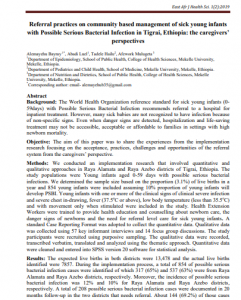
Background
The World Health Organization reference standard for sick young infants (0-59days) with Possible Serious Bacterial Infection recommends referral to a hospital for inpatient treatment. However, many sick babies are not recognized to have infection because of non-specific signs. Even when danger signs are detected, hospitalization and life-saving treatment may not be accessible, acceptable or affordable to families in settings with high newborn mortality.
Objective
The aim of this paper was to share the experiences from the implementation research focusing on the acceptance, practices, challenges and opportunities of the referral system from the caregivers’ perspective.
Methods
We conducted an implementation research that involved quantitative and qualitative approaches in Raya Alamata and Raya Azebo districts of Tigrai, Ethiopia. The study populations were Young infants aged 0-59 days with possible serious bacterial infections. We determined the sample size based on the proportion (3.1%) of live births in a year and 854 young infants were included assuming 10% proportion of young infants will develop PSBI. Young infants with one or more of the clinical signs of clinical severe infection and severe chest in-drawing, fever (37.5oC or above), low body temperature (less than 35.5oC) and with movement only when stimulated were included in the study. Health Extension Workers were trained to provide health education and counselling about newborn care, the danger signs of newborns and the need for referral level care for sick young infants. A standard Case Reporting Format was adopted to collect the quantitative data. Qualitative data was collected using 57 key informant interviews and 14 focus group discussions. The study participants were recruited using purposive sampling. The qualitative data were recorded, transcribed verbatim, translated and analyzed using the thematic approach. Quantitative data were cleaned and entered into SPSS version 20 software for statistical analysis.
Results
The expected live births in both districts were 13,478 and the actual live births identified were 7857. During the implementation process, a total of 854 of possible serious bacterial infection cases were identified of which 317 (65%) and 537 (63%) were from Raya Alamata and Raya Azebo districts, respectively. Moreover, the incidence of possible serious bacterial infection was 12% and 10% for Raya Alamata and Raya Azebo districts, respectively. A total of 208 possible serious bacterial infection cases were documented in 20 months follow-up in the two districts that needs referral. About 144 (69.2%) of those cases with possible serious bacterial infection accepted the referral, while 64 (30.8%) declined. The main reason to decline the referral for 35 (54.7%) of the families was that “no one was to accompany the infant to the next level of care”. The qualitative study findings indicated that the district health office only provide an ambulance transportation of the families with referred sick young infants to the referral hospital, but, it does not take them back home.
Conclusion
The study findings revealed high compliance to referral acceptance. This suggests that Health Extension Workers can play a significant role in the community management of sick young infants and eventually improve newborn health and reduce child mortality.